For the following compounds, write a restrosynthetic scheme and then synthetic reactions that could be used to prepare each one. Use hydrocarbons, organic halides, alcohols, aldehydes, ketones, or ester containing six carbon atoms or fewer and any other needed reagents.

Topper's Solved these Questions
- ALCOHOLS FROM CARBONYL COMPOUNDSBOOK - MS CHOUHANCHAPTER - ALCOHOLS FROM CARBONYL COMPOUNDSEXERCISE - Additional Objective Questions (Single correct Choice Type)
5 Videos
- ALCOHOLS FROM CARBONYL COMPOUNDSBOOK - MS CHOUHANCHAPTER - ALCOHOLS FROM CARBONYL COMPOUNDSEXERCISE - Additional Objective Questions (Multiple Correct Choice Type )
1 Videos
- ALCOHOLS AND ETHERSBOOK - MS CHOUHANCHAPTER - ALCOHOLS AND ETHERSEXERCISE - ADDITIONAL OBJECTIVE QUESTIONS (Matrix Match Type )
3 Videos
- ALDEHYDES AND KETONES BOOK - MS CHOUHANCHAPTER - ALDEHYDES AND KETONES EXERCISE - Level 2
7 Videos
Similar Questions
What combination of an ester and a Grignard reagent could you use to prepare the following tertiary alcohols ?
Ph−OH∣C∣CH3−CH3
View SolutionCarbon forms a large number of compounds because of its two unique properties formed many have long straight chains of carbon, branched chains of carbon or rings of carbon. In these compounds, carbon atoms may form single, double or triple covalent bonds. Compounds in which the carbon atoms are linked to each other by single bonds are called saturated carbon compounds whereas compounds having at least one carbon-carbon double or triple bond are called unsaturated carbon compounds. Compounds containing only carbon and hydrogen are known as hydrocarbons. Based on the above information, answer the following questions.
What are saturated hydrocarbons? Give one example.
View Solution
Knowledge Check
The reaction useful to separate aldehyde and ketones from other organic compound is
Aaddition of HCNBaddition of RMgXCaddition of NH3Daddition of NaHSO3Read the passage given below and answer the following questions:
Aldehydes, ketones and carboxylic acids are few of the major classes of organic compounds containing carbonyl group. Aldehydes are prepared by dehydrogenation or controlled oxidation of primary alcohols and controlled or selective reduction of acyl halides. Ketones are prepared by oxidation of secondary alcohols and hydration of alkynes. Carboxylic acids are prepared by the oxidation of primary alcohols, aldehydes and alkenes by hydrolysis of nitriles and by treatment of Grignard reagents with carbon dioxide.
Through which of the following reactions number of carbon atoms can be increased in the chain?AGrignard reactionBCannizzaro reactionCClemmenson reductionDHVZ reactionRead the passage given below and answer the following questions:
Aldehydes, ketones and carboxylic acids are few of the major classes of organic compounds containing carbonyl group. Aldehydes are prepared by dehydrogenation or controlled oxidation of primary alcohols and controlled or selective reduction of acyl halides. Ketones are prepared by oxidation of secondary alcohols and hydration of alkynes. Carboxylic acids are prepared by the oxidation of primary alcohols, aldehydes and alkenes by hydrolysis of nitriles and by treatment of Grignard reagents with carbon dioxide.
Name a method by which both aldehydes and ketones can be prepared.AReduction of carboxylic acidsBOzonolysis of alkenesCOxidation of alcoholsDAll of the above
Carbon forms a large number of compounds because of its two unique properties formed many have long straight chains of carbon, branched chains of carbon or rings of carbon. In these compounds, carbon atoms may form single, double or triple covalent bonds. Compounds in which the carbon atoms are linked to each other by single bonds are called saturated carbon compounds whereas compounds having at least one carbon-carbon double or triple bond are called unsaturated carbon compounds. Compounds containing only carbon and hydrogen are known as hydrocarbons. Based on the above information, answer the following questions.
i. Why does carbon form large number of compounds?
View SolutionRead the passage given below and answer the following questions:
Aldehydes, ketones and carboxylic acids are few of the major classes of organic compounds containing carbonyl group. Aldehydes are prepared by dehydrogenation or controlled oxidation of primary alcohols and controlled or selective reduction of acyl halides. Ketones are prepared by oxidation of secondary alcohols and hydration of alkynes. Carboxylic acids are prepared by the oxidation of primary alcohols, aldehydes and alkenes by hydrolysis of nitriles and by treatment of Grignard reagents with carbon dioxide.
How will you distinguish between aliphatic aldehydes and aromatic aldehydes?
View SolutionRead the passage given below and answer the following questions:
Aldehydes, ketones and carboxylic acids are few of the major classes of organic compounds containing carbonyl group. Aldehydes are prepared by dehydrogenation or controlled oxidation of primary alcohols and controlled or selective reduction of acyl halides. Ketones are prepared by oxidation of secondary alcohols and hydration of alkynes. Carboxylic acids are prepared by the oxidation of primary alcohols, aldehydes and alkenes by hydrolysis of nitriles and by treatment of Grignard reagents with carbon dioxide.
The reagent which does not react with both, acetone and benzaldehyde.
View SolutionRead the passage given below and answer the following questions:
Aldehydes, ketones and carboxylic acids are few of the major classes of organic compounds containing carbonyl group. Aldehydes are prepared by dehydrogenation or controlled oxidation of primary alcohols and controlled or selective reduction of acyl halides. Ketones are prepared by oxidation of secondary alcohols and hydration of alkynes. Carboxylic acids are prepared by the oxidation of primary alcohols, aldehydes and alkenes by hydrolysis of nitriles and by treatment of Grignard reagents with carbon dioxide.
Name the main compounds A and B formed in the following reaction:
CH3CN(i)CH3MgBr−−−−−−−−→(ii)H2O+AZn(Hg)/conc.HCl−−−−−−−−−−−−→B
View SolutionGrignard reagents are singma- bonded organometallic compound. There exists covalent bond between carbon and magnesium atoms. Grignard reagent finds applications in the sysnthesis of variety of compounds. Gringnard reagent reacts as carbanion and the reaction of carbanion with the proton of an acid is acid- base reaction. Cabonyl compound (including ester) on interation with grignard reagent generates alkoxide ion and thus can be converted into alcohols. Grignard reagent react with almost all functional groups. Notable exceptions are tertiary amines aliphatic and aromatic C=C bonds.
Q. Which of the following combination of reactant can be used to prepare the following given compound?

View Solution

